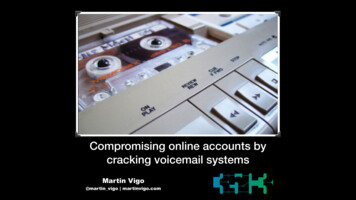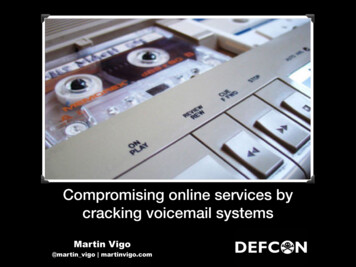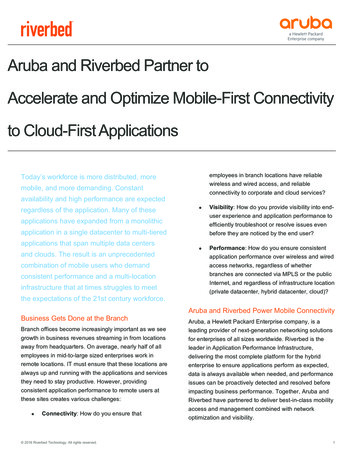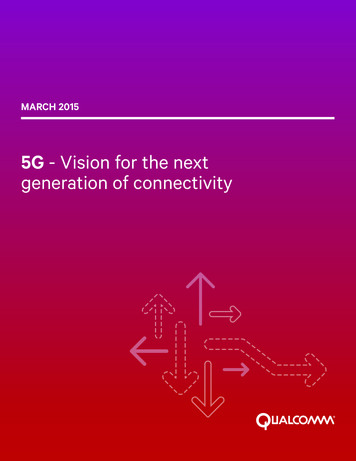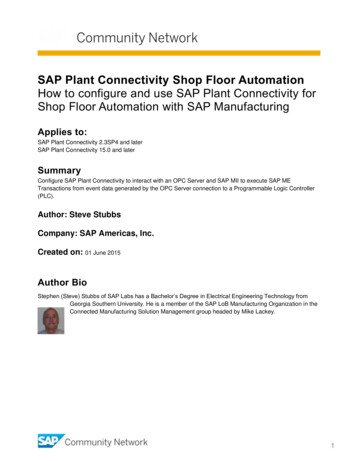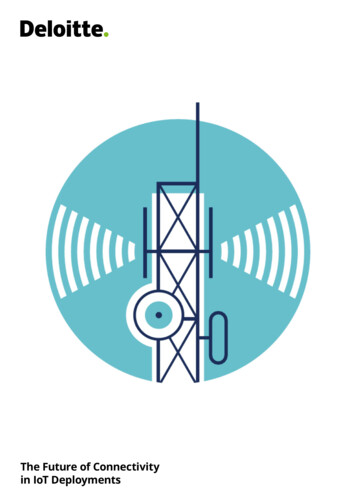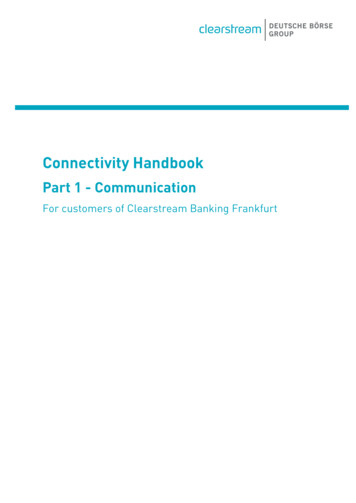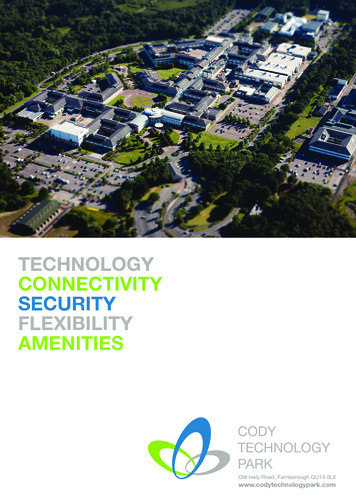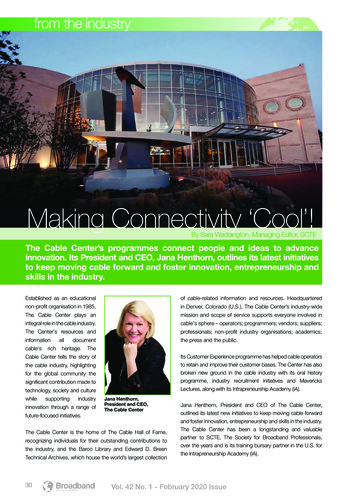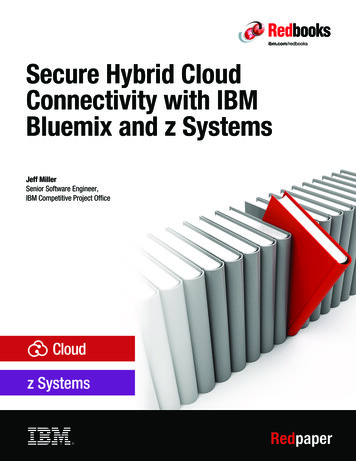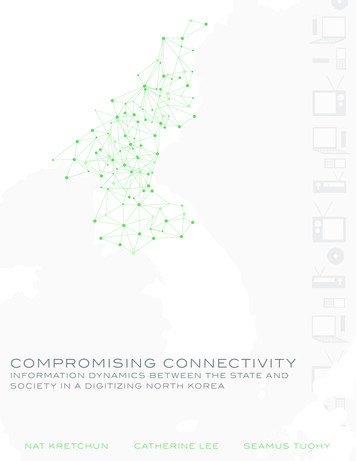
Transcription
comp romising connec t i v i t yinform at ion dy n a mics be t w een t he s tat e a ndsocie t y in a digi t i z ing nor t h kore an at k re tchunc at herine l eese a mus t uoh y
table of contents1the continuing evolution of the north korean informationenvironment4general media environment17244sources of information6media and communications devices8traditional broadcast media8television9radiodigital media17content18non-networked systems18devicesgovernment control of media in the kim jong un era25bribery26the bureaucratic specialization of media control27group 11827group 1092932official contentmobile phones32legal mobile phones in north korea34profiles of mobile phone users38mobile phones as communication devices40mobile phones as media devicesInterMedia
44mobile software–based censorship and the signaturesystem47broader mobile phone censorship and surveillancemechanisms50software-based censorship and surveillance beyondmobile devices50automated censorship51tamper resistance52surveillance and tracking mechanisms53 contradictions in digital censorship and surveillanceefforts55digitally networked spaces55intranet and internet55development of the internet in north korea56general population: the north korean intranet56 elite access: internet beyond the intranet, albeitlimited58586064hyper elite access: full unbridled internetregime’s internet strategy going forwardconnections to the outside world: chinese mobile phonesand cross-border business60chinese mobile phones62defector linksperson-to-person connection and human networks64economic and word-of-mouth networks66native content generationInterMedia
67non-media propaganda and connection to the state69the state’s youth focus71conclusion74appendix 1: telcommunications bureaucracy78appendix 2: security bureaucracy87appendix 3: data and weighting88appendix 4: survey methods89appendix 5: additional details of software-based security andsurveillance90glossaryInterMedia
data sourcesThis study primarily draws from: The 2015 Broadcasting Board of Governors (BBG) Survey of North Korea Refugees, Defectors and Travelers(N 350) A qualitative study comprised of 34 interviews with specifically recruited recent defectors conducted in May andJune of 2016 specifically for this report Technical analyses of available North Korean software and hardwarecaveatsMuch of the research conducted for this study was based on interviews with North Korean defectors, refugees andtravelers. These individuals represent some of the best sources of current information about North Korea. However,defector, refugees and travelers do not necessarily reflect in equal measure or intensity the thoughts, opinions orbehaviors of those still in-country. Furthermore, like all studies of North Korea, quantitative findings presented inthis report are not statistically representative of the North Korean population. Broad national implications should notbe drawn from this research without these important caveats firmly in mind.acknowledgementsInterMedia would like to thank the Broadcasting Board of Governors for permission to use the 2015 North KoreaRefugee, Defector and Traveler Survey.Special thanks to Michael Madden of the US-Korea Institute at SAIS/38 North and North Korea Leadership Watchwho contributed the research and writing for the appendices on the telecommunications bureaucracy and state securityapparatus.This report would not have been possible without the hard work and intellectual generosity of a vibrant community ofNorth Korea watchers in and out of government, spanning the U.S., South Korea and many other countries. Sincerethanks to you all.InterMedia
the continuing evolution of theinformation environmentIn 2012, A Quiet Opening: North Koreans in a Changing Media Environment1 described the effects of the steadydissolution of North Korea’s information blockade. Precipitated by the collapse of the state economy during thefamine of the 1990s, North Korea’s once strict external and internal controls on the flow of information atrophied asNorth Korean citizens traded with one another, and goods and people flowed across the border with China. Activitiesunthinkable in Kim Il Sung’s day became normalized, even if many remained technically illegal. A decade into the21st century, North Korea was no longer perfectly sealed off from the outside world and its citizens were much moreconnected to each other. Continued research suggests that many of the trends toward greater information access andsharing detailed in A Quiet Opening persist today. Yet, over the last four years, since Kim Jong Un’s emergence asleader, the picture has become more complicated.It is tempting to view the dynamics surrounding media access and information flow in North Korea as a simpletug-of-war: North Korean citizens gain greater access to a broader range of media and communication devices, andunsanctioned content. The North Korean government, realizing this, responds through crackdowns in an attempt toreconstitute its blockade on foreign information and limit the types of media and communication devices its citizenscan access. However, the reality is not so neatly binary. As the North Korean economic situation rebounded after thefamine and achieved relative stability,2 authorities developed strategies to establish new, more modern forms of controlwithin an environment that was fundamentally altered from its pre-famine state.Among the most significant trends to emerge in the North Korean information environment under Kim Jong Un is theshift toward greater media digitization and the expansion of networked communications. The state has ceded and nowsanctioned a considerably greater level of interconnectedness between private North Korean citizens. This, at least inpart, may be an acknowledgement the market economy in North Korea is here to stay, and thus the communicationschannels that enable the processes of a market economy must be co-opted and supported rather than rolled back.3Although the government continues to make efforts to monitor communications and dictate what subjects are offlimits, it is allowing average citizens far greater access to communications technologies. Greater digitization and digitalnetwork access are already having profound effects on the basic dynamics and capabilities that define the informationspace in North Korea.The expansion and catalyzation of person-to-person communication through mobile phones and other networkeddigital technologies is in many ways a promising development. However, as this report will document, from botha user and technical perspective, expanding network connectivity to a broad swath of the population is arming theNorth Korean government with a new array of censorship and surveillance tools that go beyond what is observed evenin other authoritarian states or closed media environments. It is clear that the state’s information control strategy, whilechanging, is not ad hoc or ill-considered. Recent technological innovations and policy changes, on balance, may begiving the North Korean government more control than they are ceding.In fact, this report’s title, Compromising Connectivity, is a nod to the dualistic nature of digital network expansionin North Korea. The state is compromising with its own citizens and the imperatives of a market economy byintroducing legal digital communications and further normalizing horizontal connections among ordinary NorthKoreans, something it long sought to prevent. At the same time however, as North Korean citizens connect to staterun digital networks their communications and other activities are compromised by new advanced digital censorshipand surveillance tools that are increasingly replacing an atrophying human security apparatus.InterMedia1
evolution of the north korean information environmentNear totalinformation blockadeand broad-based humansecurity networkinformationblockadeBreakdown oftraditional security andinformation controlapparatus leading to greaterinformation circulation andhorizontal connectionsbetween peopleNetworkedinformationcensorship andmonitoring strategy, buthorizontal tizationEven as legal digitally networked devices completely revise some features of the state’s previous information controlstrategy, with very few exceptions, foreign media remains strictly illegal and those who are caught accessing it canbe subject to harsh punishments. It is unquestionable that the North Korean regime still seeks to tightly control thetypes of information and media content its citizens consume. Credible and continuous crackdowns on foreign mediacontent have come to define the Kim Jong Un era. While research conducted for this study indicates consumptionof foreign media has not dropped off as a direct result, special units, such as Group 109, tasked with enforcing banson illegal content, have been formed and empowered. Accessing foreign media has become more, not less, sensitive inrecent years.These signs suggest that authorities are attempting to reassert control by modernizing rather than merely recreating theeconomy and surveillance state of the Kim Il Sung era. The state is now conducting more active strategic managementof the information space. It is seeking new technologically enabled ways to shape the information environment thatmeet its surveillance and security needs, as well as spur economic growth, and create the appearance of development andmodernization for the benefit of its own people and outside observers alike. While attempting to strike this balance, theNorth Korean government itself has in recent years allowed or even introduced some of the most transformative mediaand communications devices available in the country. This suggests the start of a new era of strongly state-influenceddigitization that is characterized by both sophisticated crackdowns on illegal media content and the introduction oflegal digital communications channels, currently best exemplified by mobile phones. This trend marks a significantdeparture from the relatively rapid, but spontaneous and largely uncontrolled, increases in access to information of theinitial post-famine opening period described in A Quiet Opening.This report investigates the impact of media and communications developments on the information environment inNorth Korea, as well as efforts taken by North Korean authorities to shape the information environment to meet theirown goals. To this end, the report also examines the current environment through a number of important conceptualdimensions, including:Traditional media vs. digital mediaNatural evolution vs. state directionState co-opt vs. crackdownMedia content vs. communications channelsDigitally networked vs. non-networked technologiesHuman- vs. device- vs. network-level perspectives2InterMedia
Taken together and somewhat impressionistically, we might think of these dimensions playing out in roughly thefollowing way in North Korea today. Technology is facilitating a shift toward digital forms of media consumption. Thismove toward digital media devices such as USB drives is naturally occurring and has been driven by ordinary citizens,as these devices have become available and proven well suited to the North Korean context. At the same time, the stateis developing new strategies to regain control over the media environment in the country. The government, realizingthat it cannot reinstate its near complete pre-famine information blockade, has thus adopted a strategy of acceptingand co-opting certain forms of media and communications channels. The state is thereby actively attempting to shapeand direct the country’s increasing digitization in its own best interest. Both this presumed strategic vision and thedetails of many of the state’s recent technological and policy decisions suggest the possibility for greater expansionof digitally networked spaces via mobile phones, intranet or potentially even internet. In practice, this looks like anattempt to reap the economic and surveillance benefits of new modern digitally networked communications channelswhile redoubling its efforts to curb the consumption of unsanctioned media content.These conceptual frameworks will be helpful to keep in mind as the report presents data on the current, quickly evolvingNorth Korean media and information landscape. Data were gathered primarily from surveys and qualitative interviewswith recent North Korean refugees, defectors and travelers, who experienced recent changes in the information spacefirsthand.InterMedia3
general media environmentsources of informationSurvey data reveals a continued broadening and deepening of media access in North Korea during the Kim Jong Unera. However, it is important to keep in mind the incredibly low baseline from which the country is starting. There iseffectively no independent domestic media. Foreign media is strictly prohibited and attempts to access outside newsand information can be met with harsh punishments. Freedom House ranks North Korea at the bottom of its Freedomof the Press index4 and Reporters Without Borders ranks it second to last ahead of only Eritrea.5 Given the state of themedia, it is thus natural that, like other severe authoritarian contexts, North Koreans rely on human sources, mostlyword-of-mouth, for much of the information they receive.71%figure 1: top sources of informationin north %TVTV3%ticRaignreFoWordofmoudioth3%BBG Survey of North Korea Refugees, Defectors and Travelers (2015, N 350)4InterMedia
After word-of-mouth, commonly cited trusted sources of information include a variety of media both foreign anddomestic across multiple platforms. The large disparity in reliance on human sources of information when comparedwith media sources underscores how information poor most media in North Korea is – particularly when one looksat how North Koreans obtain the kind of information that is useful to them in their daily lives. As this report willoutline, North Koreans consume a greater amount and diversity of media content than in the past. Yet, most of itremains inferior to word-of-mouth for serving routine informational needs.My perception completely changed in 1997 after meeting Korean people in China and watching KoreanTV. While I cannot entirely deny the influence of listening to the radio, the decisive experience was whenI met Korean people.- Male, 59, Pyonganbukdo, Pyonganbukdo People’s Committee affiliated trading company, Left NK2013One partial exception to this appears to be foreign radio. While only 11 percent cited it as their most important sourceof information, this represents more than one-third of the total foreign radio audience. That means a substantialproportion of listeners relied primarily on the broadcasts as a key source of information important to their daily lives.Levels of exposure to non-sanctioned information through media sources vary in North Korea from those who,fearing repercussions, made explicit efforts to avoid it When I lived in Bakchon County, I did not particularly seek out any information. It would not be anexaggeration to say that I did not even know the word “South Korea” [Hanguk/한국] prior to going toChina to earn money and living in Hyesan for three months.- Male, 29, Pyonganbukdo, Paper factory employee/83 worker,6 Left NK 2014.to those who relied upon outside information as a tool for business When I was in North Korea, I recognized that if North-South Korea relations were not good, everythingwould be cut off. The regime would also state they were unable to bring rice because the U.S. blocked themen route. Merchants would stockpile rice. For example, if one kilogram of rice was bought at 5,000 won,and if the price subsequently went up to 6,000 won, the merchants would then turn around and sell tons ofrice to people. In my case, I did not go to the extent of stockpiling rice for the purposes of reselling. I wouldjust buy a little more rice with the money I had, thinking I would not have to buy it at an expensive pricelater. If politics suffered difficulties, people would tend to hold foreign currencies.- Female, 49, Hamkyongbukdo, Diesel oil seller, Left NK 2013 to those for whom illegal information came with a search for entertainment or escape.Even though it was scary to watch South Korean dramas [because it was dangerous], I continued to watchbecause it was fun. I began to dream of a new world while watching South Korean dramas. The streetsof South Korea, places such as Myeongdong became familiar to me after watching many South Koreandramas.- Female, 20, Hamkyongbukdo, Candy maker, Left NK 2013InterMedia5
media and communications devicesThe development and diversification of the media environment in North Korea is powerfully underscored by thewide range of media devices that a substantial proportion of North Koreans can now access. Accessible, affordable,appealing and legal, media devices such as televisions and DVD players have reached near ubiquity in North Korea,with access and ownership a common phenomenon across nearly all demographic, socio-economic and political classdivides.figure 2: media and communications device accessAccess93%83%52%ComputadiPet/Tablphile2% 0%tere2% dio5% In HomeBBG Survey of North Korea Refugees, Defectors and Travelers (2015, N 350)Some of the prevailing dynamics around device use patterns can be revealed when we examine which devicesrespondents were likely to be able to access without necessarily owning them in their homes. Generally, disparities inuse patterns are driven by price, perceived usefulness and the level of sensitivity of the device in question.6InterMedia
figure 3: media and communication deviceaccess by yearTV100%RADIO SW80%RADIO ANYDVD PLAYER60%MOBILE PHONECOMPUTER40%USB20%0%20102011201220132015BBG Survey of North Korea Refugees, Defectors and Travelers (2015, N 350)When we look at the changes in individual device access since 2010,7 the rapid development of the media environmentsuggested by survey data collected since the previous version of this report was published is clear.One interviewee succinctly chronicled some of the technological substitution that has occurred in the way NorthKoreans consume foreign media such as South Korean films and soap operas.I watched a lot of South Korean dramas and movies at my friends’ houses since 2003. I watched themthrough various methods such as tapes, CDs, USB, SD cards, etc. I particularly liked the USBs becauseyou could insert it into a DVD player and connect it to a TV to watch it on a large screen. USBs are alsoconvenient for sharing movies with friends because they have a large memory [capacity]. If a USB versioncomes out, we rarely bought the CD and we just shared the movies amongst friends. After buying a cellphone, my friend would put the movies into SD cards and I would watch them alone at night.- Female, 25, Hamkyongbukdo, Service worker at the Hoeryong City Services Facilities, Left NK 2013While not all segments of North Korean society were able to acquire the most advanced media devices, for mostcitizens, devices that would allow them to consume some form of foreign media were within reach.Most farmers at least have a TV, a Notel, and recorder at home. Many of them also buy the small Chinesemade, 12-volt TVs as well. Due to lack of electricity, a lot of people use the 250 Chinese yuan solar batterycharger. Despite intensive crackdowns, people continue to watch South Korean and Chinese movies.- Male, 46, Hamkyongbukdo, Manager at a collective farm, Left NK 2015InterMedia7
traditional Broadcast MediatelevisionNearly every respondent in the survey had access to a TV. Unlike in the case of radio, in which most respondent
InterMedia. 44 mobile software–based censorship and the signature system 47 broader mobile phone censorship and surveillance mechanisms 50 software-based censorship and surveillance beyond mobile devices 50 automated censorship 51 tamper resistance 52 surveillance and tracking mechanisms .

